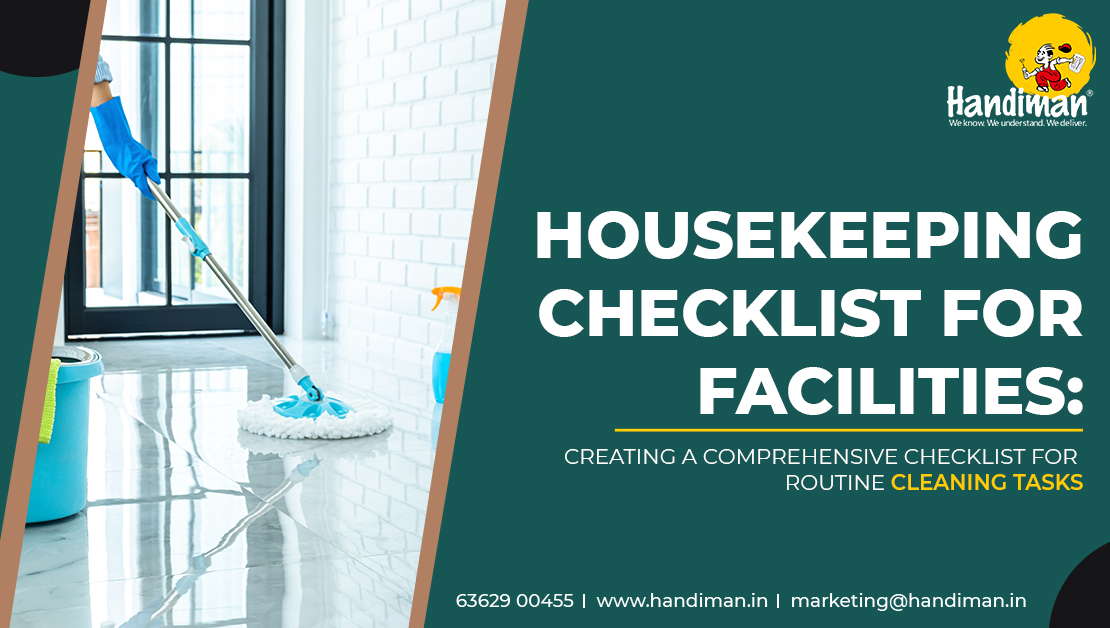
Housekeeping checklist for facilities to create a comprehensive checklist for routine cleaning tasks
Maintaining a clean and organized facility is essential for ensuring a safe and welcoming environment for residents, employees, and visitors. This can be accomplished by creating a thorough housekeeping checklist for regular cleaning chores. For facility managers, this checklist is an invaluable tool that keeps them accountable and organized.
Here's a brief guide on creating an effective housekeeping checklist:
- Identify Key Areas: Start by identifying the key areas that require routine cleaning, such as lobbies, restrooms, conference rooms, and common spaces. Make the checklist specific to the requirements of your facility.
- Enumerate Particular Tasks: Enumerate particular cleaning tasks for every area, such as dusting, vacuuming, mopping, sanitizing surfaces, and replenishing supplies. Try to be as specific as you can.
- Frequency: Establish the frequency at which each task must be completed. There are tasks that can be assigned on a daily, weekly, or monthly basis.
- Assign Responsibility: Assign cleaning tasks to specific staff members or teams. This guarantees responsibility and keeps things from getting missed.
- Equipment and Supplies: Specify the equipment and cleaning supplies needed for each task. Make sure you have all the tools you'll need on hand.
- Safety Considerations: Include safety guidelines to ensure that cleaning tasks are performed without any risks to the staff. This can entail using reservation signs, donning safeguards, and handling chemicals with care.
- Inspection and Reporting: Implement a system for regular inspection and reporting to track the completion of tasks and address any issues or deficiencies promptly.
- Continuous Improvement: Periodically review and update the checklist to reflect changing needs, facility upgrades, or feedback from staff and users.
Here's a checklist that covers routine cleaning tasks for various areas within a facility:
General Areas:
- Dust all surfaces, including shelves, tables, and window sills.
- Vacuum carpets and mop hard floors.
- Wipe down light switches, doorknobs, and handles.
- Empty and sanitize waste bins.
- Check and replace air fresheners.
- Inspect and clean mirrors and glass surfaces.
- Spot clean walls for marks or stains.
- Ensure fire extinguishers and emergency exits are accessible.
Restrooms:
- Clean and sanitize toilets, urinals, sinks, and faucets.
- Refill soap dispensers, paper towels, and toilet paper.
- Restock feminine hygiene products.
- Wipe down all touchpoints, including stall doors.
- Sweep and mop restroom floors.
- Check for plumbing issues or leaks.
- Empty and sanitize sanitary disposal containers.
Kitchen/Breakroom:
- Clear and disinfect tables, chairs, and counters.
- Wash and sanitize dishes, coffee makers, and microwaves.
- Empty and clean the refrigerator and remove expired items.
- Replace kitchen towels and dish soap.
- Sweep and mop floors.
Meeting Rooms:
- Dust and clean all furniture, including tables and chairs.
- Vacuum and mop floors.
- Wipe down whiteboards and presentation equipment.
- Ensure AV equipment is in working order.
- Check the seating arrangement and replace missing or damaged furniture.
Outdoor Areas:
- Remove litter and debris from entrances and walkways.
- Sweep or power wash outdoor surfaces.
- Trim and maintain landscaping.
- Inspect outdoor lighting for functionality and safety.
Conclusion
A well-structured housekeeping checklist streamlines cleaning operations maintains hygiene standards, and contributes to a pleasant and safe facility environment. It guarantees that no detail is missed and improves everyone's experience all around.
Regularly following this comprehensive checklist ensures a clean, safe, and welcoming environment for everyone in the facility. To keep the level of cleanliness high, customize the checklist to meet particular requirements and carry out routine inspections.
